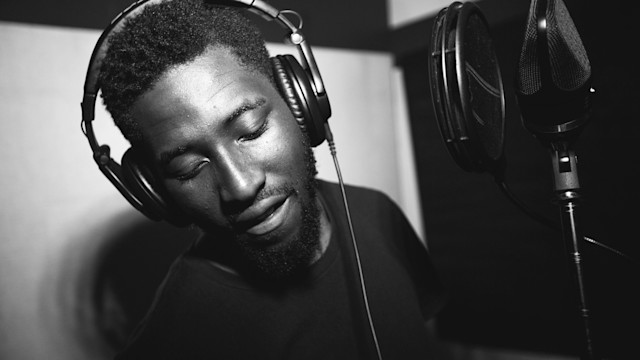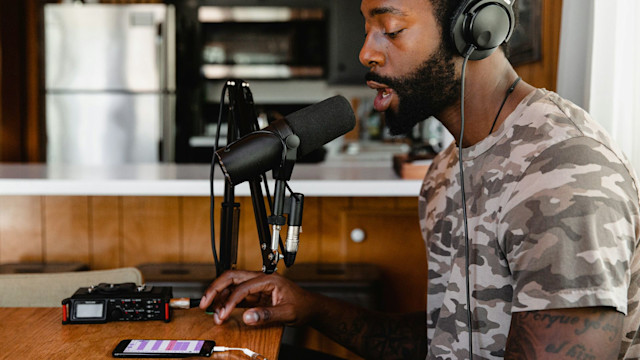Your Comprehensive Guide To Vocal Presets
September 24, 2024 - Vocal Presets have revolutionized workflow for home producers in recent years. Here’s how you can integrate them into your music.

Creating the perfect vocal plugin chain can be an arduous process, and knowing where to start is often half the battle. When recording and tracking your vocals, it can also help to have some presets loaded up which feature some compression and EQ, so you know how each vocal performance will sound with some processing applied. In this guide, we’ll cover what vocal presets are, and how their integration into your workflow can save you a lot of headaches.
Wanna try out some vocal presets for yourself? Check out Soundtrap's Vocal Presets here.
What are vocal presets?
Vocal presets are a selection of predefined parameters and settings for vocal plugins. It tends to be a mixture of EQ, compression, and delay, combined into a single preset, which can be seamlessly loaded onto a track. They are often modeled on certain microphones, genres, or the preferred settings of famous artists or producers.
Historically, vocal presets are a relatively recent development in music production. With the advent of digital audio workstations, there was an exponential increase in the number of producers looking to streamline their workflow. As a result, stock vocal presets in DAWs began to proliferate, and from there vocal presets and chains sold by third party vendors also increased.
Applying a vocal preset can instantly enhance a vocal performance and serve as a good reference for what your performance will sound like after vocal processing. As vocals are largely the most prominent part of any track, getting vocals to sit right in a mix is often the most challenging element of audio engineering. If they sound bad, it will be immediately noticeable, and bad vocal processing can very seriously make or break a track.
How to use vocal presets like a PRO | EFFECT SPOTLIGHT | 65 NEW Vocal Presets in Soundtrap
What are they used for?
Vocal presets have a wide range of different uses, and using them can be a fantastic way to get to grips with your DAW, vocal processing, and the voice of the performer. Here are a few ways many different producers make use of vocal presets.
Referencing
Referencing how your vocals sound when interacting with compressors, delays, and certain EQ settings can be a great way to evaluate what kind of performance you’re looking for. For example, you might be recording a vocal to a driving, repetitive beat. To spice things up and supplement the rhythm of the track you might want to use a delay. Dragging and dropping a vocal preset in with the delay setting you need will then reveal the best way to deliver vocal lines and phrases so they match perfectly with the delay.
Education
One of the best skills you can develop as a producer is the ability to reverse engineer what you hear. Personally, one way I made use of vocal presets was to have a look at the settings and parameters and see how certain effects were achieved.
Workflow
This is a huge one! Streamlining your workflow is a big reason vocal presets came into existence. Immediately loading up your favorite preset and applying it to your vocal performance can make things so much quicker when it comes to mixdown.
Creativity
Vocal presets (and presets in general) can be a great tool for sparking creativity. Ultimately, presets are settings recommended and designed by another producer, and their influence can influence your creativity. Next time you load your vocal preset onto your track, experiment with the settings or try loading a preset that you think might not work.
Consistency
Having presets ready is a great way to ensure consistency across multiple performances. Especially when you’re using the same microphone, in the same room and delivering the vocals in a similar way each time. This is a great way to create a sonic identity for your vocals and convey that to your audience.

Types of Vocal Presets
There are many different types of vocal presets which can be used for different genres, styles, and deliveries. The important thing to remember is that it’s not about finding the right preset for your genre, but the right preset for your voice. Here are a few types of vocal preset, as found in a DAW such as Soundtrap:
Clean
A good place to start for pop vocal processing, and if you’re just getting to grips with your DAW, clean vocal presets are great bringing out presence and clarity in your mix. The “Loud and Clear” preset on Soundtrap is one of my favorites; it has a shelf boost at 5k, which adds plenty of air into any vocal performance, helping it soar above other instruments.
Distorted
Don’t be afraid of using Distorted vocal presets just because you don’t make heavy music. Distortion and distorted vocal presets can add excitement and edge into any performance regardless of genre. A great one on Soundtrap is the “Lo-Fi” setting, which sounds tinny and understated. This can be great for a bridge or a verse, and then introducing the clearer, wide vocal preset on the chorus vocals to make a chorus sound massive.
Experimental
These types of presets can be great for creativity and for getting new ideas. My absolute favorite of these is the “Dancing Shoes” preset, which makes great use of Soundtrap’s incredible Instant Sidechain feature. The clarity of the EQ and compression settings combined with the throbbing energy of the Instant Sidechain make this vocal sound powerful and rhythmic.
Rap
Hip-Hop and Rap vocal presets are some of the most common types of vocal presets available. Delivery is often fairly consistent, which makes these types of performances perfect for presets. They are often characterized by strong articulation, punchy compression, and subtle delay for width.
How to Use Them
Using a vocal preset is thankfully, one of easiest things to do in a DAW. In a DAW such as Soundtrap, the process is streamlined and optimized to make A/Bing of different presets incredibly easy.
Record your vocal take using a blank channel.
Click on the track icon, which is to the far left of the track. For a vocal performance, this would take the form of a microphone typically.
In the track editing window, at the bottom of the screen, under the Audio tab you should see the preset you’re using listed. The standard one is “Clean.”
If you click on the little graphic to the left, a whole array of vocal presets will come up. You’ll be able to press play and audition vocal presets as you switch through them. That way you’ll be able to rely on your ears to choose for you, rather than what you think you should apply!
Mistakes to avoid
As with any workflow streamlining tool, it’s incredibly important to be mindful of how you use vocal presets, and understand some of the pitfalls of using them.
Overreliance
Probably one of the most important ones here- overreliance on vocal presets can stifle your creativity and prevent you from developing your own skills as an engineer. Combat this by taking time to study vocal processing and music production in general. The Soundtrap blog has some great resources available which are incredibly helpful- and free!
Unreliable Third Party Presets
The beauty of the internet is that anyone can sell anything with a professional website. This is also something to be wary of. If you decide to use any third party software or presets in your productions, you have to be sure that you’re getting them from a reputable source. When it comes to vocal presets, personally I like to stay in house and use what’s in my DAW, and then tweak things from there.
Never Making Your Own
At some point, you’re going to experiment with your settings on your vocal tracks, and come across something that really suits your voice and the sound you’re going for. When you do, please don’t spend forever jotting down certain plugin settings and parameters (yes, when I was first starting out). Just save the preset! You can do this on DAWs like Soundtrap by simply clicking on the ‘Save Preset’ button towards the top of the track editing window.
Conclusion
So there you have it! A comprehensive guide on vocal presets, which should help get you started in processing those killer vocal performances. Experiment, have fun, and try to learn a thing or two from the presets you come across. You’ll start to notice patterns and similarities which will then inform your own production as you get more comfortable with your DAW.
About the author
Max McLellan is a composer, songwriter, and audio engineer with credits ranging across film, TV and radio. He provides composition, mixing, and mastering services through his company MKM Audio.
Beginnen Sie noch heute mit Soundtrap!